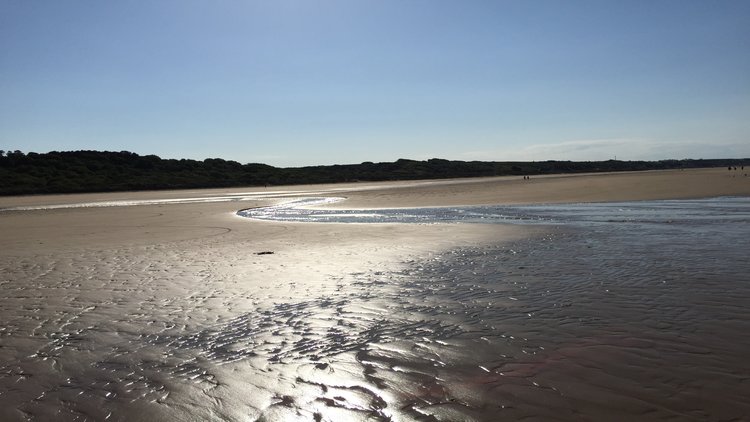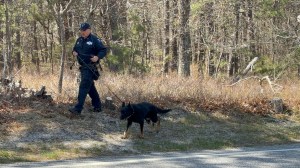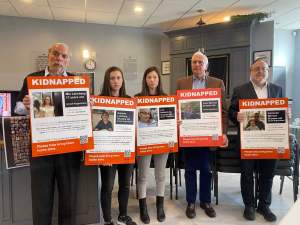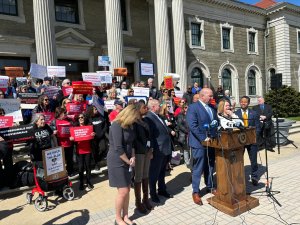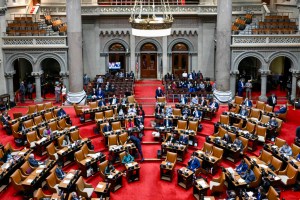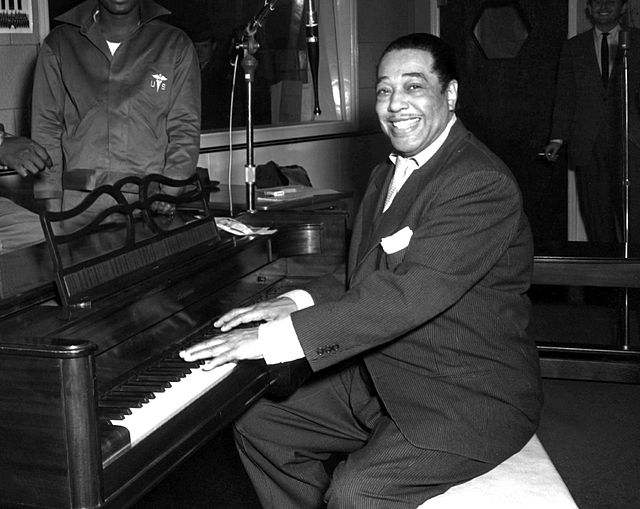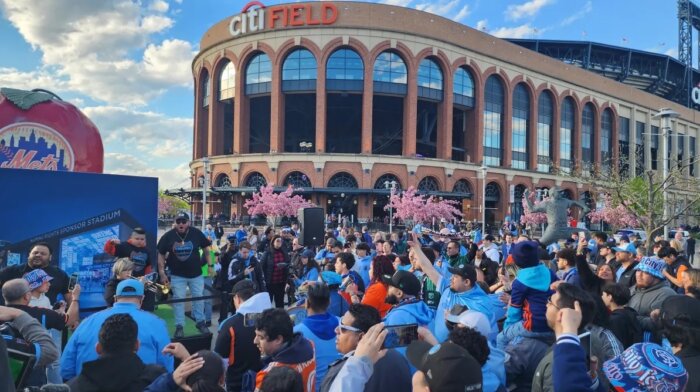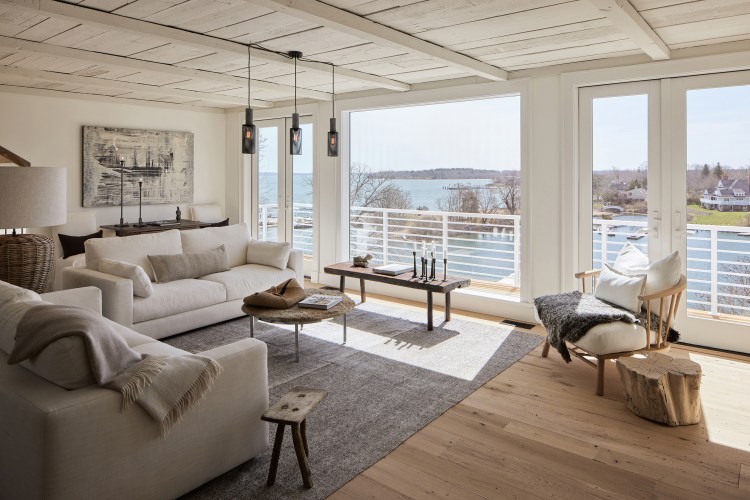Standing barefoot on Omaha Beach, the sand silky soft, the warm waters of the English Channel lapping gently against me, I thought it was a perfect summer day. The sun shone brightly in a clear blue sky. The tide was low, leaving a wide expanse between the sparkling surf and the dark green bluffs past the dunes where a path led to the stairs that would take us back to the American Normandy Cemetery.
It’s so hard to imagine that here was where “all hell broke loose” on that bloody gray dawn of D-Day, June 6, 1944. Officially known as Operation Overlord, the Allied invasion of Normandy would be the largest amphibious assault in history. There’d be 5,000 ships of all sizes; 11,000 aircraft and some 156,000 American, British and Canadian soldiers, hitting five beaches along a 50-mile front. Omaha was the bloodiest.
In the heat of battle, Col. George Taylor reportedly told his men, “There are two kinds of people who are staying on this beach: those who are dead and those who are going to die. Now let’s get the hell out of here.”
My earliest memories of the D-Day invasion were in black and white, because I’d seen the images taken by famed photographer Robert Capa for Life Magazine. What I’ve since learned is that he shot 108 frames when he landed with the soldiers at Omaha Beach, but a lab technician had ruined all but 11 of them in his haste to process them in time for a flight across the Atlantic to the editors in New York. That explains why the surviving ones are slightly out of focus, too.
In 1962, Hollywood released its black and white movie about Normandy called The Longest Day, which had a cast that included Sean Connery, Henry Fonda, Robert Mitchum, John Wayne and Richard Burton, to name a few box-office stars. Today’s millennials could re-experience the landing by watching the terrifying opening minutes of Saving Private Ryan, starring Tom Hanks, which came out in 1998.
Omaha and Utah were the codenames for the American landings to the west; the British had Gold, Juno and Sword beaches to the east. One of the military goals was to seal off Normandy’s Cotentin peninsula and eventually seize its port, Cherbourg, but by the time the Allies finally captured that city, the Germans had left the harbor in ruins.
These days, Normandy thrives on a tourist industry catering to veterans and others who want to remember the war. Today, driving from Omaha Beach to Utah Beach takes about a half hour, but traversing those 47 kilometers through the impenetrable hedgerows of the Bocage region took days of bloody fighting in 1944.
In Saint Mere Eglise, you can see a dummy dangling from the church tower high above the central square. Back on D-Day, the GI named John Steele was less conspicuous—and therefore survived—because this paratrooper from the 82nd Airborne Division had gotten his parachute stuck on the tower’s other side when he landed as part of the pre-dawn aerial assault behind enemy lines. In The Longest Day, Steele was played by Red Buttons, a carrot-topped American comic actor born in the Lower East Side who became a top star in the early days of television. His scene is one of the few comedic moments in that very long war movie.
Before the Normandy invasion, Gen. Dwight D. Eisenhower, the supreme commander, was a nervous wreck, smoking up to five packs of cigarettes a day and consuming bottomless cups of coffee. The first week of June the weather had turned bad. A huge storm barreled into the English Channel, churning up the seas with high winds and complicating the coordination plans. He knew there was only a small window when the tidal conditions would be right for the kind of amphibious assault the Allies intended: a low tide rising at daybreak.
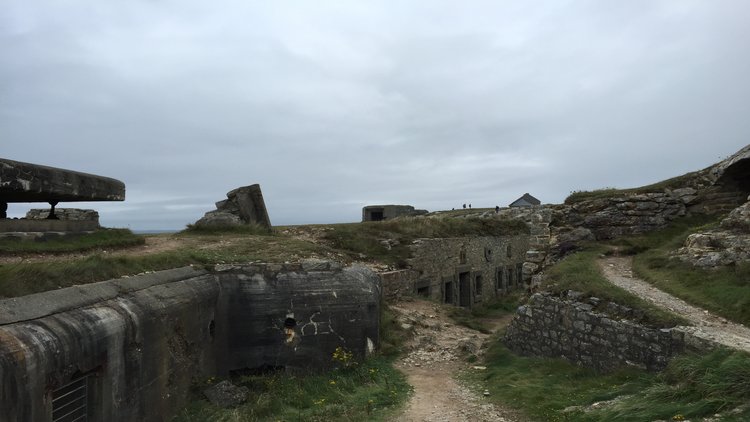
It was no secret the Allies were coming by sea. Germany’s Nazi ruler, Adolf Hitler, had put Field Marshall Erwin Rommel in charge of stopping the invasion, authorizing him to build the Atlantic Wall, a 2,400-mile fortification of cement bunkers, long-range guns, landmines on telephone poles jutting out of the sand, booby traps underwater, spiked iron staves designed to rip open the hulls of incoming boats, and other metal obstacles that would pin down our men in high or low tide.
Rommel knew the invasion was coming but he didn’t know where, or when. The Allies had created a deception, complete with Hollywood-concocted fake tanks and bogus planes, codenamed Operation Fortitude, to make the Germans think Gen. George Patton, whom they regarded as the Allies’ smartest general—a perception he also shared—would cut across between Portsmouth and Calais, the shortest distance between England and France. They wouldn’t dare crossing the widest part of the English Channel, would they? When the storm rolled in, Rommel convinced himself that he could leave his elegant chateau estate near Bayeux and celebrate his wife’s birthday back home in Germany. Today the chateau still stands but it’s in private hands.
By June 5, 1944, Gen. Eisenhower had already held back the invasion 24 hours and he didn’t want to delay another day. Many men were already on their ships and landing crafts, getting cold and seasick. He feared that one German surveillance aircraft flying over the Channel might eliminate the element of surprise, which really was one of the only advantages the Allies had. Fortunately, even the Germans had grounded their planes that day because of the weather.
Before the troops boarded, each soldier, sailor and airman of the Allied Expeditionary Force had been given a copy of the “Orders of the Day,” a letter Eisenhower had drafted:
“You are about to embark upon the Great Crusade, toward which we have striven these many months. The eyes of the world are upon you. The hopes and prayers of liberty-loving people everywhere march with you. In company with our brave Allies and brother-in-arms on other Fronts, you will bring about the destruction of the German war machine, the elimination of Nazi tyranny over the oppressed peoples of Europe, and security for ourselves in a free world.”
The plan was to start the invasion at 6:30 a.m. And so it went. Relatively speaking, Utah Beach was a cakewalk, even though Gen. Teddy Roosevelt, Jr., the president’s 57-year-old son, had landed 2,000 yards off target because of the strong currents and the stiff winds. He turned to his men and said, “We’re going to start the war from here.” He faced minimal opposition, as did the Brits and Canadians on their beaches.
At Omaha Beach, the Americans ran into a shit storm. The naval bombardment had been cut too short to do any damage to the defenses, and the Allied aircraft had flown too far inland where their bombs did nothing but kill cows and horses. The tanks and bulldozers intended to provide cover on the beach had been released too far from shore and many sank immediately. The first wave of soldiers were too loaded down with heavy packs that impeded their maneuverability. Yet, ahead of them lay hundreds of yards, all under unrelenting enemy fire from crack reinforcements from a German division that had recently been on the Eastern Front fighting the Soviets. Not at all the level of resistance the brass had led them to expect.
“The eyes of the world are upon you. The hopes and prayers of liberty-loving people everywhere march with you.”
– Gen. Eisenhower
When the doors of the landing craft opened, the embarking soldiers were exposed to the dark bluffs where the Germans were entrenched in concrete bunkers. It was like shooting ducks in a barrel. Our troops had to wade waist-deep past the dead bodies floating in the incoming water. They had been trained to ignore the cries of the wounded and head straight to the dunes where the Germans held the high ground with their protected artillery. Casualties reached the thousands.
By 10:30 a.m., the invasion was going so badly that Gen. Omar Bradley, watching from a ship off shore, wanted to call it off and rescue the remaining men. His German counterpart, looking at the carnage on the beach from his protected bunker on the bluff, came to the same conclusion, sending a message to his commander that the Germans had turned the tide.
Both officers were wrong.
Today you can walk freely around the most strategic part of Omaha Beach, Pointe du Hoc, where the Germans had their artillery emplacement that enabled them to blow ships out of the Channel and rake our troops on the wide stretch of sandy beach. You can stand at the edge of a 130-foot cliff that our Army Rangers had to climb rapidly in order to knock it out of commission. You don’t hear the machine gun fire, the bombs blasting, just the wind and the sea below, as you try to put yourself in their shoes.
When my wife and I were in France this summer, two off-duty U.S. military members and their friend had tackled and subdued a heavily armed man on a high-speed train bound for Paris, reportedly “breaking up what could have been a deadly terrorist attack.”
Childhood friends from Sacramento, Calif., the three Americans were enjoying the ride through Belgium when they heard a gunshot. Twenty-three-year-old Airman First Class Spencer Stone—a great name if I do say so myself—ran and tackled the gunman. His pal Army Spc. Alek Skarlatos, 22, a member of the Oregon National Guard, who had been deployed in Afghanistan, grabbed the assailant’s AK-47 rifle while their friend Anthony Sadler, 23, a student at Sacramento State University, assisted them.
The gunman was a 25-year-old Moroccan man named Ayoub El-Khazzani, whom French intelligence officials said belonged to “the radical Islamist movement.” He’d emerged from an onboard restroom heavily armed when an unnamed French man trying to enter confronted him. That’s when the first shot rang out and the Americans sprang into action.
French President Francois Hollande wanted to personally thank them for their bravery in an official ceremony at the Elysee Palace. When they later met President Obama in the Oval Office, he said they represented “the very best of America and the American character.”
“They were thinking they were just going to have a fun reunion in Paris and ended up engaging in a potentially cataclysmic situation,” Obama said at the White House. “Because of their courage, because of their quick thinking, because of their teamwork, it’s fair to say a lot of people were saved, and a real calamity was averted.”
The news of their courage made me think of my sons back home who are around their age. Then I got to thinking of the brave soldiers landing on Normandy Beach who once were their age as well. When I was in my early 20s, I was protesting the Vietnam War because I was draft age. Years later, my ex-brother-in-law, who fought in the dense jungles around Da Nang, forgave me. I don’t know what I would have done in the heat of battle, and I hope I never find out.
But I do know that this summer was a good time to be an American in Paris.
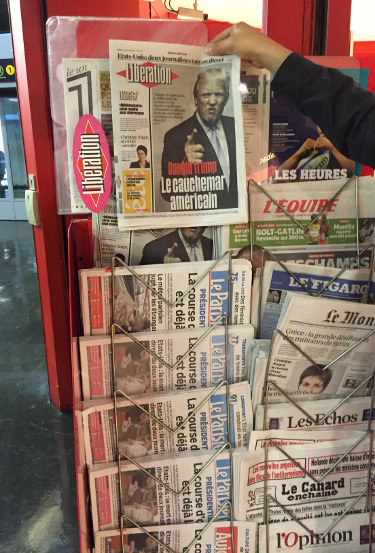
The Allies had liberated the City of Light in August, 1945. My wife and I arrived 70 years later. As we got off the train from Nice, the beautiful city overlooking the French Riviera, the first newsstand I saw had a rack of angry Donald Trumps glaring from the front page of France’s Liberation newspaper. It was the quintessential “ugly American,” and I was taken aback because I hadn’t thought about his presidential campaign for weeks.
But he wasn’t the only Yankee the French seemed to be thinking about in August. Plastered on walls all around Paris were posters of JFK and Jackie. It turned out to be a promotional campaign for a photo exhibit devoted to the Kennedys. When we saw the show on a Sunday afternoon, about two dozen people were packed into the gallery’s upstairs room watching a French documentary recounting the president’s assassination.
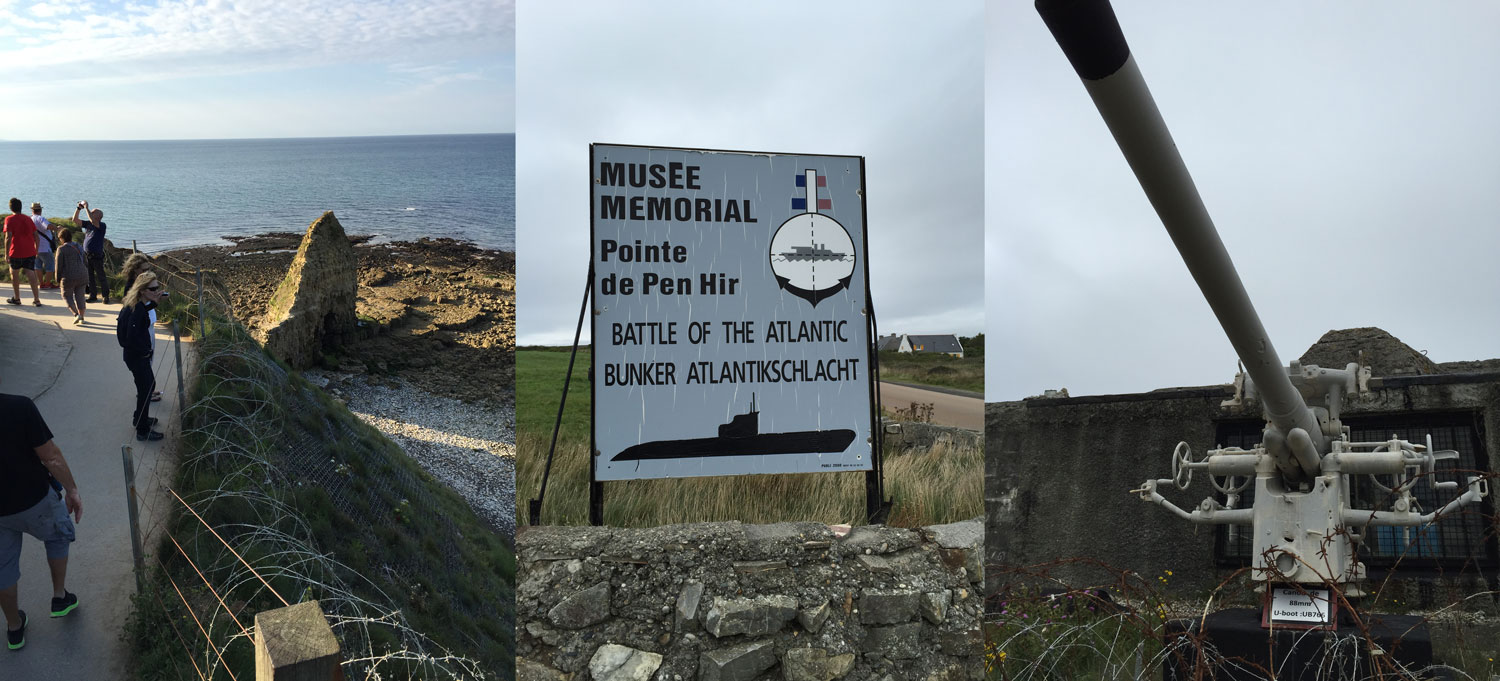
In January, the big news in France was about Charlie Hebdo, the satirical weekly, whose offices had been attacked by armed gunmen allegedly angered over the publication’s depiction of the Prophet Mohammad. Twelve staffers had been slain, including the editor. As offensive as the publication deliberately was, it was a bastion of free speech.
We didn’t plan to visit the site of the massacre but we did come upon a packed opening one night for the Galerie Glenat in the Marais district featuring renderings of Titeuf, a well-known French cartoon character of a kid with a bright yellow tuft of hair sticking out of his head. On the wall was a Charlie Hebdo magazine cover by an illustrator named Luz, which showed an adolescent Titeuf wearing a backpack facing his mirror image with a yellow beard who had an AK-47 on his back. The latter one says, “I have jihad tomorrow.” His schoolboy friend replies, “You have it good. I have math.” For the exhibit, Luz had dropped red ink on one corner of the cover. It was a subtle reminder of the blood shed that day.
When we went to Notre Dame, like so many tourists before us, we learned there’d been a ceremony honoring surviving American veterans of WW II that very morning. They were long gone from the cathedral by then. But knowing they had been welcomed for their service decades ago still resonated in the air.
And on this Veterans Day, 70 years after the end of the Great War, it’s the right time to pay tribute to all the soldiers who’ve gone before and honor the ones who survive.
On the eve of D-Day, just as he was about to board his ship, Keith Douglas, a 24-year-old British poet, started a poem he called “Actors in the Wings,” and it had this stanza: “Everyone, I suppose, will use these minutes to look back, to hear music and to recall what we were doing and saying that year during our last few months as people, near the sucking mouth of the day that swallowed us all into the stomach of war.”
He never wrote another line. He was killed by a mortar round a few days after landing in Normandy.



